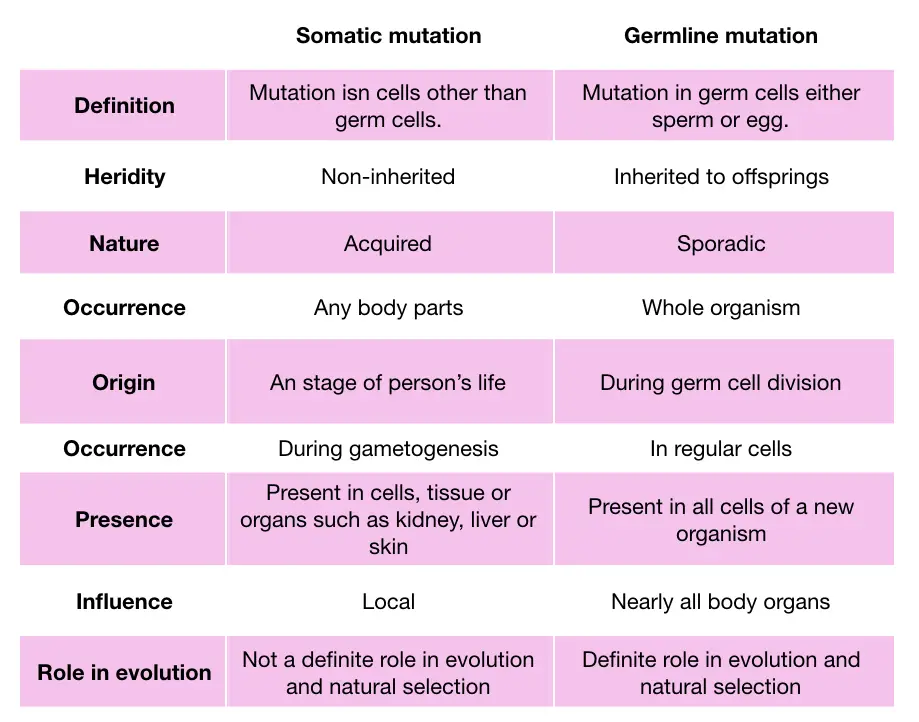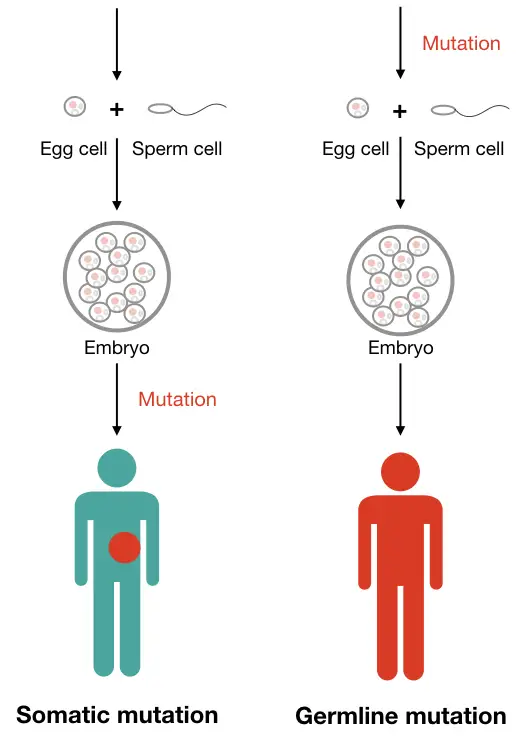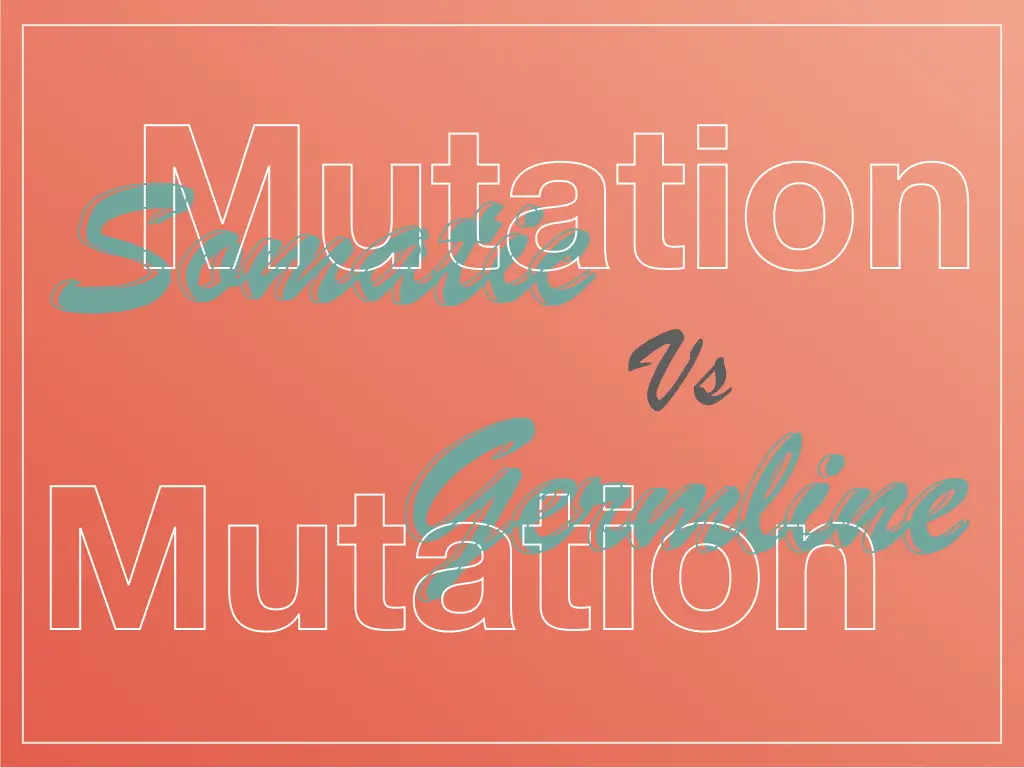“Somatic mutations occur in somatic cells and can’t be inherited whilst the germline mutations occur in germ cells and inherited onto offspring.”
- 3 somatic mutations are reported per healthy individual
- 2 to 6 mutations occur per million base pairs in our genome.
- Somatic mutations aren’t always harmful; the Generation and diversity of B cell receptors, T cell receptors and antibodies are indeed caused by somatic hypermutations. Those help to defend our body.
- The rate of somatic hypermutation is 1,000,0000 times higher than normal somatic cells.
- Germline mutations affect nearly all systems of our body.
If you are searching for this article on Google, I can wonder, you know what mutation or genetic mutation is! However, if you don’t; don’t worry about it, I will give you a quick outlook.
A mutation is often precisely known as the genetic mutation or gene mutations are the types of polymorphism in our genome that aren’t so useful to us, meaning causes a certain type of problem to a person either related to mental or physical.
In genetics, genetic mutation is any sudden change that occurs in our genome and produces serious congenital, mental or developmental problems. Commonly, chromosomal mutations and gene mutations are of two types which I already have discussed in our previous article, you can read it here: Genetic Mutations- Definition, Types, Causes and Examples.
DNA is present in a cell; our body is made up of two types of cells viz, somatic cells and germ cells. Sperm and egg cells are two types of germ cells that basically take part in the formation of a zygote. A whole new organism is formed from germ cell fusion.
Our body is made up of different cell types and forms tissues and other organs. The genetic content or the genome is located in the nucleus of the cell. The genome is the entire set of DNA present in a cell.
I have written a short section on somatic vs germline mutation in our previous article, I am writing this article to make this point more clear. So here is the article illustrating all the information on somatic and germline mutations and their differences.

Key Topics:
What is somatic mutation?
Cells other than the germ cells- egg or sperm are somatic cells which are 220 different types. When any sudden change occurs in the somatic DNA, it produces somatic mutation.
Definition:
A detectable, non-inherited and pathogenic change or mutation that occurs in the somatic cells is referred to as somatic mutation.
Somatic mutation commonly results in cancer; tissue or organs specific cancer.
UV light, X-rays, radiation, chemicals, heat and other environmental factors are extrinsic factors while DNA damage, oxidative stress and replication errors are common intrinsic factors to cause somatic mutation.
Any factors either intrinsic or extrinsic directly damage the DNA or break DNA/ gene. Although the body’s natural DNA repair mechanism can repair it, it causes acquired (somatic) mutation if it remains unrepaired.
Mutation frequency is an important factor in explaining somatic mutations to detect, treat, and manage them. The somatic cell mutation frequency is very high.
In addition to this, it may vary among cells, tissue, organs and species. Meaning, some cells have a high mutation rate and some have less. It also depends on the factor involved, the intensity of mutagenesis and the time of exposure. But!
Do you know that somatic mutations are helpful for us also!
Yes, you heard it right!
Mutation in the immunoglobulin coding genes produces many different immunoglobulins (antibodies) as per the response. Also, various B cell and T cell receptors are formed.
Immunoglobulins are antibodies, a type of protein that produces an immune response against antigens. Receptors of B cells and T cells further provide binding sites for foreign particles.
Every immunoglobulin for every single antigen is different and that is why mutations form different combinations. The mutation rate of those cells is 1,000,000 times more than other somatic cells, the process is said as somatic hypermutation.
It is a mechanism that strengthens our adaptive immune system. Notedly the normal somatic mutation rate is 2 to 6 mutations per million base pair. Eventually, most of them are either nonexpressive or repaired immediately.
Somatic mutations can be acquired at any stage of life. Along with other factors, age is, moreover, a well-established factor too involved in somatic mutagenesis. Age-related cancer and neurodegenerative disorders are the two best examples of somatic mutations.
It is also important to understand that mutations also occur at the chromosome level too, such as chromosome deletion, duplication or translocation. However, characterizing somatic mutations is quite difficult as are low frequency, less abundant and repaired in most cases.
In addition, these variations aren’t present in all cells or tissues which is yet another limitation in studying, diagnosing and treating somatic mutations. It is said to be a “soma” or mutant “clone” when spread to new cells or surrounding tissues and is shown in cancer so often.
Inheritance pattern of somatic mutation:
Somatic mutations don’t follow any clear inheritance pattern as they are non-inherited. However, as it can pass on to adjacent cells, It can pass on in either dominant or recessive patterns.
In the dominant conditions, a single allele is enough to cause the disease while in recessive conditions two different alleles are needed.
Examples of somatic mutation:
Cancer:
Somatic cell cancer is one of the most common causes of this kind of mutations. It’s a tissue or organs specific condition in which mutation in proto-oncogenes or oncogenes, at any stage of life results in cancer.
Common genes are P53, APC, VHL, ATM, XPA etc. When genes mutate, it results in an imbalance in the cell cycle which can be spread to other cells too. Colon cancer, lung cancer and skin cancer are some of its examples.
Related article: Cancer Genetic Testing- What Is It and How It is Done?
Neurological disorders:
Several somatic mutations also possibly produce several to mild neurological conditions at adult-onset or later onset of a person’s life. Parkinson’s disease is an example that well explains somatic mutations.
Other examples are Autism spectrum disorders, Focal cortical dysplasia, hemimegalencephaly and schizophrenia. Genes like PTEN, PIP3, PDPK1, AKT, TSC1 and 2, RHEB and RagA/B are several genes involved in varied neurological conditions.
In addition to this, other developmental, metabolic and reproductive problems are also caused by different somatic gene mutations.
What is germline mutation?
Egg and sperm cells are kinds of germ cells present in us and other higher eukaryotes. Both are haploid in nature having a single set of 23 chromosomes. Oocyte or egg cell and sperm cell fuses and forms the diploid zygote. Diploid cells have 46 chromosomes (2n), in pairs.
When any change or mutation occurs in germ cells, and not in somatic cells, it is said germline mutation.
Definition:
A detectable, heritable and pathogenic mutation that occurs in germ cells, is referred to as germline mutation.
“Heritability” is an important characteristic of germline mutations. While those changes can transmit to offspring; four types of inheritance are autosomal dominant, autosomal recessive, X-linked dominant and X-linked recessive.
If somatic mutations are “acquired” then germline mutations are constitutional in nature, stable and low-frequency, therefore it is said as “constitutional mutations” too.
The constitutional mutations usually originate during the prezygotic/pre-fertilization stage or during the meiosis cell division of germ cells.
Though external mutagens cause mutagenesis in germinal tissues, majorities are inherited from parents. Noteworthy, if these mutations aren’t inherited from parents, it is said as de novo.
Endogenous factors such as replication errors, nondisjunction, abrupt chromosome distribution and oxidative stress, and exogenous factors such as UV light, teratogens, ionizing radiations and chemicals are common germinal mutagens.
From these factors, imbalanced chromosome distribution and nondisjunction cause mutation at the chromosome level while the rest are involved in DNA or gene mutation.
Notedly, the rate of sperm cell mutation is higher than the oocytes because of the lifelong cell differentiation of sperm cells.
- Germline dominant mutation: A single dominant copy of a gene is sufficient enough to cause the disease.
- Germline recessive mutation: Two copies of recessive alleles or gene copies are required to cause the disease.
It is also important to know that not all germline mutations are inherited, for example, the complete trisomy 21, 18 or 13. These chromosomal mutations arise congenitally, though aren’t inherited to offspring. As we said, those are de novo mutations, meaning, occur randomly during the meiosis cell division. Some translocation trisomies can pass down to offspring.
Inheritance pattern of germline mutation:
As I said, several ways to pass down germline mutations are autosomal dominant, autosomal recessive, X-linked dominant and X-linked recessive. If you wish to learn things in detail, you can read our previous article on it: Different type of inheritance pattern: Genetic Inheritance.
A single dominant autosomal allele that is sufficient to cause disease, is referred to as autosomal dominant. For example, Marfan syndrome and Huntington’s disease.
When two different recessive alleles cause disease, is referred to as autosomal recessive. For example, sickle cell anemia and cystic fibrosis.
A single dominant X-linked gene is sufficient to cause disease, is said as X-linked dominant. For example, Fragile X syndrome.
When two different recessive alleles cause a disease, it is said as X-linked recessive. For example, Fabry disease and Hemophilia.
Here are some of the best examples of different germline mutations that make things more understandable.
Examples of germline mutation:
Cystic fibrosis:
Cystic fibrosis is an autosomal recessive CFTR gene mutation having complex symptomatic presentations. Mutation in the CFTR gene affects the function of the mucus lining of epithelial cells or many epithelial tissues.
Read more here: Cystic fibrosis.
Huntington’s disease:
Huntington’s disease is an autosomal dominant condition involving a mutation in the HTT gene. It’s also known as triplet repeat explanation disorder results in many brain function dysregulation including uncontrolled movement, abnormal behaviors and other motor and cognitive problems.
Read more here: Huntington’s disease.
Fragile X syndrome:
Fragile X syndrome is an X-linked dominant disorder in which only a single dominant copy of a mutated gene causes disease. Also known as triplet repeat expansion disorder, in which an abnormal triplet repeat CGG expands to cause abnormal phenotypes.
Common phenotypes are related to mild to moderate mental retardation and intellectual disabilities. The gene is located in the X-chromosome.
Hemophilia:
Two types of bleeding disorder Hemophilia A and B are caused by the mutation in F8 and F9 genes, respectively. It’s an X-linked recessive disorder. Two recessive mutant alleles are required to cause the disease.
Hemophilia is a bleeding disorder, here because of the mutation in genes coding for blood clotting factors, slow or unstopped bleeding problems are reported. The condition becomes, even more, worsen when bleeding occur internally.
Trisomy 18:
Trisomy 18 is a kind of aneuploidy in which an extra copy of chromosome 18 presents with the pair. Symptoms of mental, developmental and motor disabilities are reported. The condition is commonly non-inherited.
Read more: Trisomy 18- Definition, Symptoms, Pictures, Diagnosis And Life Expectancy.

Somatic vs germline mutation- Differences:
The somatic mutation occurs in the somatic cells of us whilst the germline mutation occurs in germ cells either sperm, egg or both.
The somatic mutation causes a varied degree of genetically mosaic individuals or produces mosaicism by affecting the somatic tissues. On the other side, germline mutation forms completely mutant organisms; the mutation is detectable and heritable as well.
An organism acquired the somatic mutation during its life and henceforth known as acquired mutation which is exclusively non-inherited.
While if we talk about the germline mutation, it passes to offspring and henceforth known as hereditary mutation.
So the above point proves that the somatic mutation isn’t transmitted to offspring but the germline mutation is!
Depending upon the rate of mosaicism, the severity of somatic mutations can be measured. It can not be categorized further.
Contrary, the severity of the germline mutation depends on the inheritance pattern. Different types of inheritance patterns are autosomal dominant, autosomal recessive, X-linked dominant and X-linked recessive.
At any stage of an organism’s life, acquired mutation (somatic mutation) can be produced and affects organs like the kidney, liver, muscles and skin, etc. It occurs at any cell division stage during the whole life. For example, acquired cancer, skin cancer, dysfunctional kidney, etc.
When we talk about the germline mutation, that occurs only during the gametogenesis and affects multiple or all systems of our body including, the circulatory system, nerve system, excretory system and blood system, etc. For example, cystic fibrosis, Down syndrome or Huntington’s disease.
Let’s make this point more clear. When skin cells are attacked by teratogens, mutagens or UV light, epithelial skin cells get damaged and cause skin cancer -somatic mutation.
When imbalanced chromosome distribution occurs during germ cell formation it causes aneuploidies like trisomy 21- Down syndrome -germline mutation.
Symptoms of trisomy 21 are severe mental retardation, facial abnormalities, heart defects, kidney function problems, etc.
So the effect of somatic mutations is cell, tissue or organ-specific while the effect of germline mutation includes multiple systems or organs.
We can say the effects of somatic mutation are local, acquired or may be temporary and can be fixed. However, the effects of germline mutation are huge, to all cells, permanent and can’t be fixed. Meaning, somatic mutations can be treated or cured but germline mutations can neither be treated nor be cured.
Scientists are testing several gene therapies, gene silencing technologies, CRISPR-CAS9 tools and other gene alteration methods to cure germline mutations.
Either mutation can be associated with evolution too and explains natural selection. If you have learned the fundamentals of natural selection, that clearly indicates that somatic mutations don’t have any significant effect on evolution or natural selection.
It’s temporary and can’t be inherited and that’s why a new mutation is neither selected nor evolved in nature.
Nonetheless, germline mutations have a pivotal effect on natural selection and evolution. If the new mutation is good, I mean, helpful to us, it gets selected, transmitted and evolved in nature.
“Heritable traits favor evolution by natural selection.”
Somatic mutations are less complex in comparison to germline ones. The severity of the mutation, especially for somatic mutation depends on at which stage it originates.
For example, if it occurs during the mitotic cell division, meaning in dividing cells, it spreads to surrounding tissues or the same type of cells. The effects are larger and more severe.
If it occurs after mitosis or at the postmitotic stage, the effects are less severe or nearly negligible and hence symptoms are less severe.
In contrast to the whole scenario, the germline mutation is totally a different thing, once it occurs, it directly transmits to offspring either in a dominant or recessive pattern- affects all body cells.
Cancer and somatic & germline mutation:
In general, cancer is sporadic/ acquired and is non-inherited, however, some can! – like breast cancer.
Cancer is the best example of somatic cell mutations caused by carcinogens. Agents that cause cancer are carcinogens, for example, UV light, viruses, chemicals or radiation.
Cancer is tissue or organ-specific which means when genes of some tissue are mutated it causes sporadic cancer. Those genes usually are either proto-oncogenes, tumor suppressor genes or oncogenes, which participate basically in regulating cell division.
Cancer can’t be passed from parent to child if it is sporadic in nature- 80 to 90% of cancer is sporadic.
Contrary to sporadic cancer, germline cancer is different. Here, again, when a mutation occurs during fertilization, it transmits to the fetus, like breast cancer. These types of cancer are classified as inherited cancers. Inherited cancer is lethal and difficult to cure.
Plants are asexual organisms and do not have definite germ cells, by creating somatic plant mutations, a whole new plant can be produced.
Summary:
| Somatic mutation | Germline mutation |
| Somatic mutations occur in all body cells except germ cells. | Germline mutations are detectable variation occur in germ cells- sperm or egg. |
| It occurs during organisms’ whole life. | It occurs during gametogenesis and hence mutation covers all cells formed from it. |
| Is known as acquired mutation. | Is known as a sporadic mutation |
| Can’t pass down to offsprings as it doesn’t occur in the embryo | Can pass down to offerings as it occurs in the embryo |
| Affect any body part or organ | Affect whole organism and nearly all body parts or system |
| Can be managed or treated. | Can’t be treated or cured. |
| Common examples are Cancer, neurological problems and kidney function problems. | Common examples are Cystic fibrosis, Huntington’s disease and Hemophilia. |
| Mosaicism is reported | Usually, mosaicism isn’t reported |
| Can’t affect natural selection or evolution | Affect natural selection and evolution |
| Are non-inherited | Are inherited |
Conclusion:
Techniques such as Real-time PCR, DNA sequencing, quantitative PCR, ARMS-PCR, FISH and other sequencing-based techniques, the researcher uses to examine and study somatic and germline mutations.
Somatic mutations can be managed, somehow but germline mutations are a difficult scenario, as we said, multiple organs are involved in it.
Genetic mutations most are inherited and so germinal, however, any change in DNA or chromosome are classified as genetic mutations.
For a newbie, this article is an excellent material to understand the fundamentals of mutations. If you like this article please share it with our friends.
Subscribe to our weekly newsletter for the latest blogs, articles and updates, and never miss the latest product or an exclusive offer.




